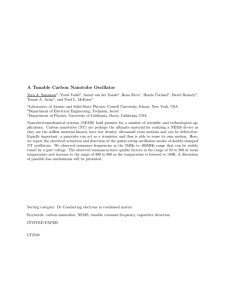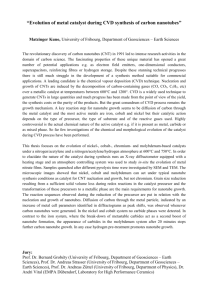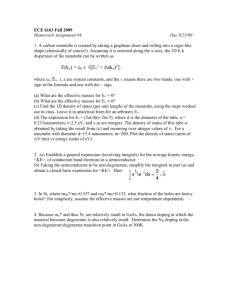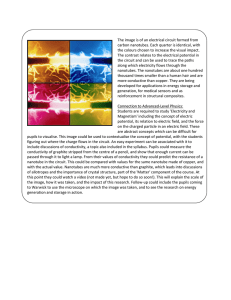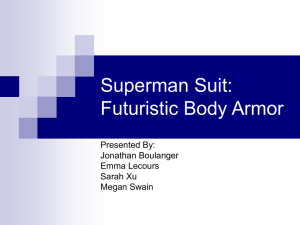Nanofabrication of top-gated carbon nanotube
advertisement
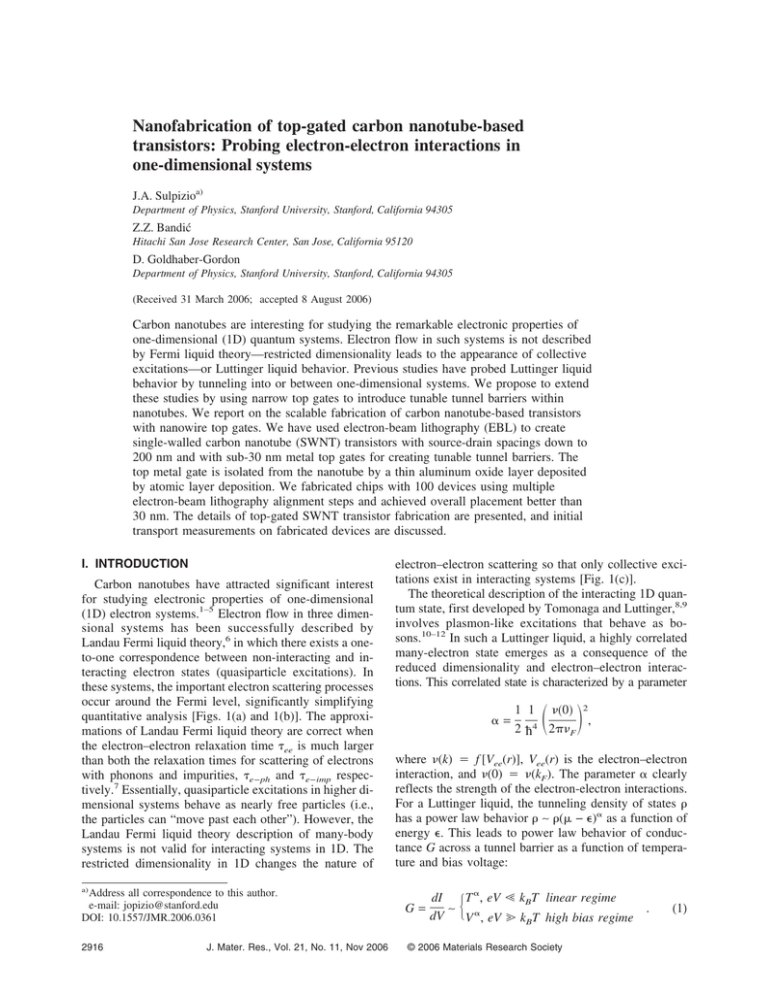
Nanofabrication of top-gated carbon nanotube-based transistors: Probing electron-electron interactions in one-dimensional systems J.A. Sulpizioa) Department of Physics, Stanford University, Stanford, California 94305 Z.Z. Bandić Hitachi San Jose Research Center, San Jose, California 95120 D. Goldhaber-Gordon Department of Physics, Stanford University, Stanford, California 94305 (Received 31 March 2006; accepted 8 August 2006) Carbon nanotubes are interesting for studying the remarkable electronic properties of one-dimensional (1D) quantum systems. Electron flow in such systems is not described by Fermi liquid theory—restricted dimensionality leads to the appearance of collective excitations—or Luttinger liquid behavior. Previous studies have probed Luttinger liquid behavior by tunneling into or between one-dimensional systems. We propose to extend these studies by using narrow top gates to introduce tunable tunnel barriers within nanotubes. We report on the scalable fabrication of carbon nanotube-based transistors with nanowire top gates. We have used electron-beam lithography (EBL) to create single-walled carbon nanotube (SWNT) transistors with source-drain spacings down to 200 nm and with sub-30 nm metal top gates for creating tunable tunnel barriers. The top metal gate is isolated from the nanotube by a thin aluminum oxide layer deposited by atomic layer deposition. We fabricated chips with 100 devices using multiple electron-beam lithography alignment steps and achieved overall placement better than 30 nm. The details of top-gated SWNT transistor fabrication are presented, and initial transport measurements on fabricated devices are discussed. I. INTRODUCTION Carbon nanotubes have attracted significant interest for studying electronic properties of one-dimensional (1D) electron systems.1–5 Electron flow in three dimensional systems has been successfully described by Landau Fermi liquid theory,6 in which there exists a oneto-one correspondence between non-interacting and interacting electron states (quasiparticle excitations). In these systems, the important electron scattering processes occur around the Fermi level, significantly simplifying quantitative analysis [Figs. 1(a) and 1(b)]. The approximations of Landau Fermi liquid theory are correct when the electron–electron relaxation time ee is much larger than both the relaxation times for scattering of electrons with phonons and impurities, e−ph and e−imp respectively.7 Essentially, quasiparticle excitations in higher dimensional systems behave as nearly free particles (i.e., the particles can “move past each other”). However, the Landau Fermi liquid theory description of many-body systems is not valid for interacting systems in 1D. The restricted dimensionality in 1D changes the nature of electron–electron scattering so that only collective excitations exist in interacting systems [Fig. 1(c)]. The theoretical description of the interacting 1D quantum state, first developed by Tomonaga and Luttinger,8,9 involves plasmon-like excitations that behave as bosons.10–12 In such a Luttinger liquid, a highly correlated many-electron state emerges as a consequence of the reduced dimensionality and electron–electron interactions. This correlated state is characterized by a parameter ␣= 冉 冊 1 1 共0兲 2 , 2 4 2F where (k) ⳱ f [Vee(r)], Vee(r) is the electron–electron interaction, and (0) ⳱ (kF). The parameter ␣ clearly reflects the strength of the electron-electron interactions. For a Luttinger liquid, the tunneling density of states has a power law behavior ∼ ( − ⑀)␣ as a function of energy ⑀. This leads to power law behavior of conductance G across a tunnel barrier as a function of temperature and bias voltage: a) 再 dI T ␣, eV Ⰶ kBT linear regime ∼ ␣ dV V , eV Ⰷ kBT high bias regime Address all correspondence to this author. e-mail: jopizio@stanford.edu DOI: 10.1557/JMR.2006.0361 G= 2916 © 2006 Materials Research Society J. Mater. Res., Vol. 21, No. 11, Nov 2006 . (1) J.A. Sulpizio et al.: Nanofabrication of top-gated carbon nanotube-based transistors: Probing electron-electron interactions in 1D systems FIG. 1. Failure of Fermi liquid theory for 1D electron gas. In Fermi liquid theory for three-dimensional systems, (a) single electron energy levels and (b) interacting electron energy levels exhibit a one-to-one correspondence; quasiparticle excitations behave as nearly free particles (i.e., the particles can “move past each other”).1 (c) Such a description is not valid in a 1D electron system, since the nature of electron-electron scattering changes, and only collective excitations may exist. For a normal Fermi liquid, energy-independent tunneling is expected and the tunneling conductance is independent of bias and temperature.1,2 As predicted theoretically, nanotubes have been shown to exhibit Luttinger liquid behavior in transport measurements.1,2 Previous experimental efforts include tunneling between two Luttinger liquids in a kinked nanotube system. In these experiments, only the extreme cases of no tunnel barrier and strong tunnel barrier were studied. Additionally, the onset of Coulomb blockade due to poorly transmitting contacts prevented Luttinger liquid measurements at very low temperatures. Interesting experimental questions remain about how the conductance behaves in the other tunneling regimes and at lower temperatures. We propose to study tunneling between Luttinger liquids in a single-walled carbon nanotube (SWNT) device across a tunable tunnel barrier induced by narrow (20–30 nm) metal top-gate electrodes. Local gating of nanotube devices with top gates has recently been achieved.3 Although Luttinger liquid behavior has only been previously observed via transport measurements in metallic nanotubes,1,2 Luttinger liquid behavior may be expected in both metallic and semiconducting nanotubes. The Luttinger liquid may emerge in any 1D electronic system where the electronic band structure can be linearized around the Fermi level; the presence of a band gap would not change this as long as the Fermi level lies above the gap (which is the case for the gated nanotube). By measuring G= dI dV between the source and drain contacts as a function of narrow gate voltage, we aim to achieve tunneling between Luttinger liquids in various regimes of barrier transmission, and to quantitatively measure the strength of electron-electron interactions. Most of the previous studies of carbon nanotube transistors3 have involved locating individual nanotubes by atomic force microscopy (AFM) and contacting them individually, whereas our approach is more scalable, as we rely on the probabilistic placement of the nanotubes using lithographically defined catalyst fields. Specifically, this probabilistic approach allows us to pre-define regions in which carbon nanotubes will grow, and therefore fabricate many topgated devices at once. In addition, such a probabilistic approach has not been used before for nanofabricaton of carbon nanotube devices with several narrow top gates. II. CARBON NANOTUBE GROWTH AND CHARACTERIZATION Prior to the carbon nanotube growth, catalyst regions were lithographically defined on the substrate surface. J. Mater. Res., Vol. 21, No. 11, Nov 2006 2917 J.A. Sulpizio et al.: Nanofabrication of top-gated carbon nanotube-based transistors: Probing electron-electron interactions in 1D systems FIG. 2. (a) Nanotube emerging from the catalyst pad made of iron oxide nanoparticles embedded in alumina and (b) carbon nanotube visible in the finished device. The highlighted sections indicate the position of the nanotube. The substrate was spincoated with poly(methyl methacrylate) (PMMA) electron beam (e-beam) resist, and 4 × 4 regions were exposed and developed in resist. The formulation of catalyst used was 20 mg ferric nitrate monohydrate and 15 mg alumina dissolved in 15 ml of methanol, ultrasonicated for 2 h prior to deposition. The catalyst solution was deposited by pipette directly onto the PMMA-coated and patterned substrate. Catalyst regions were lifted off by allowing the solvent to evaporate under nitrogen, heating the substrate to 70 °C, and lifting off residual catalyst on PMMA resist in acetone. This procedure effectively creates iron oxide nanoparticles embedded in an alumina matrix.13 Single-walled carbon nanotubes were grown in a quartz tube furnace at temperatures between 800 °C and 950 °C. Before initiating growth, the furnace was ramped to growth temperature over a period of approximately 15 min under flow of 500 sccm of hydrogen. The standard gases and flow rates used during growth were methane (1000 sccm), hydrogen (500 sccm), and ethylene (25 sccm). Typical growth time varied between 5 and 10 min. Figure 2(a) shows nanotube emerging from the catalyst pad. Growth conditions were tuned to optimize for the growth of SWNTs as opposed to multiwalled nanotubes. AFM was used to verify nanotube diameter. Measured diameters of approximately 1 nm were considered as strong indicators of single-walled nanotubes. Figure 3(a) shows an AFM image of a nanotube emerging from an iron oxide nanoparticle catalyst pad, while Fig. 3(b) shows the cross-section AFM profile of the same nanotube measured in the labeled region. The measured diameter of the nanotube is 1.2 nm. Figures 3(c) and 3(d) show another example of a nanotube emerging from the catalyst pad with a measured diameter of 0.8 nm. FIG. 3. (a) Nanotube emerging from the catalyst pad made of iron oxide nanoparticles embedded in alumina. (b) Cross-section profile of the nanotube shown in (a). The diameter of the nanotube is 1.2 nm. (c) Nanotube emerging from the catalyst pad. (d) Diameter of the tube shown in (c) is measured as 0.8 nm. 2918 J. Mater. Res., Vol. 21, No. 11, Nov 2006 J.A. Sulpizio et al.: Nanofabrication of top-gated carbon nanotube-based transistors: Probing electron-electron interactions in 1D systems FIG. 4. Fabrication of carbon nanotube-based transistors. III. CARBON NANOTUBE TRANSISTOR FABRICATION Figure 4 shows steps used in the fabrication of CNT chips. The substrate used for fabrication was a degenerately doped Si substrate with 100 nm-1 m thick thermally grown SiO2 film. A Leica VB6 e-beam tool was used for the aligned lithographic steps in the fabrication. The typical alignment achieved was 15–20 nm for 3. In the first step, alignment marks were lithographically defined in PMMA resist, then transferred by CHF3-based reactive ion etching into the SiO2 film. These alignment marks were then used in all subsequent EBL steps. Following alignment mark definition, we defined catalyst regions for individual devices, and lifted off iron oxide/alumina catalyst material solution in methanol, as described in Sec. II. Each individual SWNT device employs two 4 × 4 m catalyst regions separated by 7 m. After iron oxide/alumina catalyst regions were defined, SWNTs were grown as described in Sec. II. The catalyst regions on the SWNT chips were intentionally positioned in the growth furnace so that the gas FIG. 5. Fabricated SWNT transistor with top gates. J. Mater. Res., Vol. 21, No. 11, Nov 2006 2919 J.A. Sulpizio et al.: Nanofabrication of top-gated carbon nanotube-based transistors: Probing electron-electron interactions in 1D systems flow direction was parallel with the line connecting two catalyst marks. Following SWNT growth, EBL with alignment, followed by e-beam evaporation and lift-off of Pd were used to define 40-nm–thick Pd low Schottky barrier (ohmic) contacts to the nanotubes.13 The spacing between contacts, which defined the length of the active region of the carbon nanotube, varied between 200 nm and 5 m. These channel lengths were chosen to compromise between finite-size effects and the probability of point defects in the nanotubes. After Pd ohmic contacts were defined, Ti(10 nm)/Au(35 nm) large area source and drain contacts were lifted off and aligned to Pd contacts. The devices were then annealed in Ar at 220 °C for 10 min to improve the contact resistance. Prior to definition of narrow top gates, a 6–30-nm–thick alumina layer was deposited by atomic layer deposition to isolate the electrically contacted nanotube. Finally, EBL with alignment and lift-off process was used to define 20 nm wide Ti(5 nm)/Au(20 nm) nanowire gates between the region defined by Pd contacts. One of the final device structures is shown in Fig. 5. IV. PRELIMINARY TRANSPORT MEASUREMENTS Figures 6(a) and 6(b) show room temperature conductance traces G= dI dV as a function of the back-gate voltage (applied to the bulk of the conductive silicon substrate) for two representative devices. The contacts are highly transmitting, and the devices can be fully depleted, suggesting semiconducting SWNTs. Such devices are promising candidates for local gating experiments. The top gates will be characterized carefully by low temperature transport measurements to avoid potential room temperature damage to the devices. Preliminary conductance measurements (down to T ⳱ 4 K) as a function of top-gate voltage on similar devices with 30 nm alumina top-gate insulation suggest that the top gate does not locally electrostatically couple to the nanotube, but instead couples to the entire channel (for channel lengths down to 200 nm). However, we expect to achieve local gating with the thinner alumina insulation of 6 nm. V. CONCLUSIONS Interacting electron systems in 1D cannot be effectively described with the Landau Fermi liquid model. SWNTs are potentially interacting 1D systems exhibiting Luttinger liquid behavior and can be locally gated with the fabrication of top gates. We have fabricated narrow gate nanotube transistor devices using scalable methods to study tunneling transport in a Luttinger liquid, with the carbon nanotubes grown from lithographically defined 2920 FIG. 6. (a) and (b) Room temperature conductance versus back-gate voltage of representative devices with channel lengths of 500 nm. The devices have highly transmitting contacts and can be fully depleted. This suggests the devices contain semiconducting SWNTs, and are promising candidates for future local gating experiments. catalyst regions. This approach allowed for parallel fabrication of a large number of devices. Multiple e-beam exposure and alignment steps were used to define device geometry, low-barrier Pd contacts, and dielectrically insulated 20-nm–wide top gates. Preliminary transport measurements indicate semiconducting devices that are deplete-able with highly transmitting contacts, suggesting the devices are well suited for Luttinger liquid tunneling measurements with local narrow top gates. ACKNOWLEDGMENTS This work was partially supported by The Air Force Office of Scientific Research. JAS acknowledges support from a National Science Foundation Graduate Research Fellowship. J. Mater. Res., Vol. 21, No. 11, Nov 2006 J.A. Sulpizio et al.: Nanofabrication of top-gated carbon nanotube-based transistors: Probing electron-electron interactions in 1D systems REFERENCES 1. M. Bockrath, D.H. Cobden, J. Lu, A.G. Rinzler, R.E. Smalley, L. Balents, and P.L. McEuen: Luttinger-liquid behaviour in carbon nanotubes. Nature 397, 598 (1999). 2. Z. Yao, H.W.Ch. Postma, L. Balents, and C. Dekker: Carbon nanotube intramolecular junctions. Nature 402, 273 (1999). 3. M.J. Biercuk, S. Garaj, N. Mason, J.M. Chow, and C.M. Marcus: Gate-defined quantum dots on carbon nanotubes. Nano Lett. 5, 1267 (2005). 4. A. Javey, H. Kim, M. Brink, Q. Wang, A. Ural, J. Guo, P. McIntyre, P. McEuen, M. Lundstrom, and H. Dai: High-k dielectrics for advanced carbon-nanotube transistors and logic gates. Nat. Mater. 1, 241 (2002). 5. A. Javey, J. Guo, Q. Wang, M. Lundstrom, and H. Dai: Ballistic carbon nanotube field-effect transistors. Nature 424, 654 (2003). 6. L.D. Landau and E.M. Lifshitz: Statistical Physics (Pergamon Press Ltd., New York, 1977). 7. W. Harrison: Solid State Theory (Dover Publications, New York, 1980). 8. S. Tomonaga: Remarks on Bloch’s method of sound waves applied to many-fermion problems. Prog. Theor. Phys. 5, 544 (1950). 9. J.M. Luttinger: An exactly soluble model of a many-fermion system. J. Math. Phys. 4, 1154 (1965). 10. T. Giamarchi: Quantum Physics in One Dimension (Oxford Univ. Press, New York, 2004). 11. K. Schnhammer and V. Meden: Fermion-boson transmutation and comparison of statistical ensembles in one dimension. Am. J. Physiol. 64, 1168 (1996). 12. C. Kane, L. Balents, and M.P.A. Fisher: Coulomb interactions and mesoscopic effects in carbon nanotubes. Phys. Rev. Lett. 79, 5086 (1997). 13. J. Kong, A.M. Cassell, and H. Dai: Chemical vapor deposition of methane for singlewalled carbon nanotubes. Chem. Phys. Lett. 292, 567 (1998). J. Mater. Res., Vol. 21, No. 11, Nov 2006 2921




